Long Range Reconnaissance Imager

Long Range Reconnaissance Imager (LORRI) is a telescope aboard the New Horizons spacecraft for imaging.[1] LORRI has been used to image Jupiter, its moons, Pluto and its moons, and Arrokoth since its launch in 2006.[2][3] LORRI is a reflecting telescope of Ritchey-Chrétien design, and it has a main mirror diameter of 208 mm (8.2 inches) across.[4][5] LORRI has a narrow field of view, less than a third of a degree.[4] Images are taken with a CCD capturing data with 1024 × 1024 pixels.[4] LORRI is a telescopic panchromatic camera integrated with the New Horizons spacecraft, and it is one of seven major science instruments on the probe.[5] LORRI does not have any moving parts and is pointed by moving the entire New Horizons spacecraft.[5]
Operations[edit]


LORRI was used to calculate albedos for Pluto and Charon.[6] LORRI is also used for navigation, especially to more precisely determine the location of a flyby target.[7] In 2018, New Horizons spacecraft used navigation data from LORRI for its planned flyby of Arrokoth in a couple months.[8]
During the cruise to Jupiter, LORRI data was also used to determine a value for the cosmic optical background as an alternative to other methods.[9] At Jupiter, LORRI was used for an extensive observation campaign of Jupiter's atmosphere, rings, and moons.[4]
On August 29, 2006, the cover on LORRI was opened and it took an image in space of Messier 7 (aka Ptolemy’s Cluster) for its first light image.[10] The following year, in 2007 when it flew by Jupiter for its gravity assist, it was used to image Jupiter and its moons.[11] LORRI also imaged the Jovian system in 2010 as part of an annual checkout confirming the operation of LORRI, taking pictures from a distance of about 16 AU.[11]
In 2015, LORRI was used to image Pluto before and during the flyby.[12] In December 2017, LORRI took an image at a greater distance from Earth than Pale Blue Dot by Voyager 1, in this case of the Wishing Well Cluster.[13] This cluster was also the first light image for the Wide Field and Planetary Camera of the Hubble Space Telescope, taken in May 1990.[14]

In August 2018, LORRI was able to detect Arrokoth at distance of around 161 million kilometres (100 million miles).[15]
A large stack of images of Arrokoth from August to December 2018 was used to confirm a closer flyby, rather than more distant by ruling out moons and rings systems to a certain level of detection.[16]
On the night of December 24, 2018 LORRI was used to take images of Arrokoth at a distance of 10 million kilometres (6.2 million miles).[17] Three images were taken each with a half second long exposure, at a 1024x1024 pixel resolution.[17][18]
Specifications[edit]
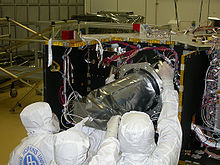
LORRI is a reflective telescope integrated with the New Horizons spacecraft. It can take greyscale images of astronomical targets.[4]
- Telescope style: Ritchey-Chrétien
- Aperture: 208 mm (8.2 inches)
- f/12.6
- Effective focal length 2630 mm (103.5 inches)[4]
- Mirror substance: Silicon Carbide
- Mass: 8.8 kilograms (19.4 pounds)
- Average electrical power use: 5.8 watts
- Field of View: 0.29 degrees
- Resolution: 4.95 μrad pixels[4]
- Bandpass: from about 350 nm to 850 nm[4]
- Operating temperature: 148K to 313K[20]
- Sensor: E2V Technologies CCD47-20 and Analog Devices AD9807 ADC[21][22]
- Frame-Transfer Back-Illuminated CCD
- Size: 13.3×13.3 mm
- Pixel size: 13×13 μm native size with 4×4 pixel on-chip binning possible
- 1024×1024 active pixels
- 12 bits ADC
The mirror is made of silicon carbide which helped support meeting the thermal requirements of the design.[20]
The instrument is a thinned backside-illuminated charge-coupled device, and captures images at a resolution of 1024 by 1024 pixels, with a variety of exposure settings.[4] LORRI can take one picture per second and store the picture digitally as a 12-bit image, with either lossless or lossy compression.[4] (See also Data compression)
LORRI incorporates a field-flattening lens with three elements.[21]
The design can take images at very low light levels required for the mission, including light levels 1/900 those of Earth when it is at Pluto.[4] For the Arrokoth encounter the longest exposure time (up to ten seconds for the Pluto flyby) was increased.[23] This was accomplished after the Pluto flyby by the team, to support taking images in even lower light levels.[24]
After the Pluto flyby, exposure times of at least 30 seconds were made possible, which was also useful for taking reconnaissance images and enabling imaging down to a magnitude of 21.[25]
LORRI is pointed by moving the entire spacecraft, which limits the exposure time.[5][21] The spacecraft does not have reaction wheels and is stabilized by thrusters.[21]
| Examples | |||||||
| Name | Wavelength Bandpass | Aperture(s) | |||||
|---|---|---|---|---|---|---|---|
| Human eye | 400–700 nm (approx.)[26] | 6 mm[27] | |||||
| LORRI | 350 – 850 nm | 208 mm | |||||
| Alice | 70-205 nm[28][29] | (two; 40 x 40 mm2 1 mm [30] | |||||
Jovian system[edit]
While passing by Jupiter in February 2007, the Jovian system was observed using LORRI and other instruments.[31]
LORRI views of the Galilean moons:

Pluto[edit]
Due to its telescope power, LORRI was able to capture images of Pluto and its moons, offering the closer views as the spacecraft flew by the dwarf planet.
-
Long range view with Pluto and moons circled. (stars processed out)
-
Observation of Pluto and Charon from January 2015
-
LORRI image of Pluto and Charon in June 2015
-
Days before closest approach, LORRI views the other side of Pluto
-
Mountain range on Pluto near Tombaugh Regio
-
What is thought to be a frozen pond on Pluto, about 20 miles (30 kilometers) across
-
Several images from LORRI composited together
Charon[edit]

15810 Arawn[edit]
In 2016 New Horizons observed the Kuiper belt object, 15810 Arawn. It is the object that is pointed with an arrow.[32]

486958 Arrokoth[edit]
Long-distance views[edit]
-
LORRI image of 486958 Arrokoth from July 2017
-
Arrokoth among the stars of Sagittarius, imaged by New Horizons in late 2018. Its apparent magnitude from the spacecraft decreased from 20 to 15.[33]
-
Arrokoth viewed on December 24, 2018 by LORRI[34]
Approach views[edit]
-
Wiggle animation of Arrokoth
-
With arrows
-
Arrokoth as seen by LORRI during its approach, and released on January 1, 2019.[35]
-
Arrokoth as seen by LORRI on January 1, 2019, at distance of 18,000 miles (28,000 kilometers).
Closest views of Pluto flyby[edit]
Since LORRI had the highest magnification of the instruments, it captured the closest views of Pluto's terrain during the flyby. Its smaller field of view was panned across Pluto, capturing a stripe of the dwarf planet's terrain.

See also[edit]
- HiRISE
- Mars Orbiter Camera
- List of New Horizons topics
- DART Spacecraft, using Didymos Reconnaissance and Asteroid Camera for Optical navigation (DRACO) Imager, based on LORRI
- Lucy, using L'LORRI, based on LORRI
References[edit]
- ^ Talbert, Tricia (2015-03-26). "Long Range Reconnaissance Imager (LORRI) Instrument". NASA. Retrieved 2018-10-15.
- ^ Taylor, Alan. "The Voyage of New Horizons: Jupiter, Pluto, and Beyond". The Atlantic. Retrieved 2018-10-15.
- ^ Tavares, Frank (2020-02-13). "Arrokoth Revealed: A First In-Depth Look at a Pristine World". NASA. Retrieved 2020-09-16.
- ^ a b c d e f g h i j k l Cheng, A. F.; Weaver, H. A.; Conard, S. J.; Morgan, M. F.; Barnouin-Jha, O.; Boldt, J. D.; Cooper, K. A.; Darlington, E. H.; Grey, M. P.; Hayes, J. R.; Kosakowski, K. E.; Magee, T.; Rossano, E.; Sampath, D.; Schlemm, C.; Taylor, H. W. (2009). "Long-Range Reconnaissance Imager on New Horizons". New Horizons. pp. 189–215. doi:10.1007/978-0-387-89518-5_9. ISBN 978-0-387-89517-8.
- ^ a b c d e "New Horizons Mission Spacecraft". Johns Hopkins Applied Physics Lab. Retrieved November 12, 2022.
- ^ Buratti, B. J.; Hofgartner, J. D.; Hicks, M. D.; Weaver, H. A.; Stern, S. A.; Momary, T.; Mosher, J. A.; Beyer, R. A.; Verbiscer, A. J.; Zangari, A. M.; Young, L. A.; Lisse, C. M.; Singer, K.; Cheng, A.; Grundy, W.; Ennico, K.; Olkin, C. B. (2017). "Global albedos of Pluto and Charon from LORRI New Horizons observations". Icarus. 287: 207–217. arXiv:1604.06129. Bibcode:2017Icar..287..207B. doi:10.1016/j.icarus.2016.11.012. S2CID 118330416.
- ^ "New Horizons Sets Up for New Year's Flyby of Ultima Thule - Astrobiology Magazine". Astrobiology Magazine. 2018-10-09. Retrieved 2018-10-15.
- ^ "Engine burn puts New Horizons on track to Ultima Thule". SpaceFlight Insider. 2018-10-09. Retrieved 2018-10-15.
- ^ Zemcov, Michael; Immel, Poppy; Nguyen, Chi; Cooray, Asantha; Lisse, Carey M.; Poppe, Andrew R. (2017). "Measurement of the cosmic optical background using the long range reconnaissance imager on New Horizons". Nature Communications. 8: 15003. arXiv:1704.02989. Bibcode:2017NatCo...815003Z. doi:10.1038/ncomms15003. PMC 5394269. PMID 28397781.
- ^ "Great Exploration Revisited: The 2007 Flyby of Jupiter".
- ^ a b JHUAPL. "LORRI Looks Back at "Old Friend" Jupiter". New Horizons. Retrieved 2018-11-09.
- ^ "New Horizons". pluto.jhuapl.edu. Archived from the original on 2015-07-15. Retrieved 2018-11-09.
- ^ a b "Great Exploration Revisited: The 2007 Flyby of Jupiter".
- ^ First Image Taken by Hubble's Wide Field Planetary Camera, Hubblesite.org
- ^ JHUAPL. "Ultima in View". New Horizons. Retrieved 2018-11-09.
- ^ "New Horizons Sees No Moons or Rings around Ultima Thule, Opts for Primary Flyby Path | Space Exploration | Sci-News.com". Breaking Science News | Sci-News.com. 19 December 2018. Retrieved 2018-12-19.
- ^ a b "New Horizons: Image?page=1&gallery_id=2&image_id=560". pluto.jhuapl.edu. Retrieved 2018-12-31.
- ^ "New Horizons: News Article?page=20181226". pluto.jhuapl.edu. Retrieved 2018-12-31.
- ^ "NASA - LORRI Instrument".
- ^ a b Robichaud, J.; Green, J.; Catropa, D.; Rider, B.; Ullathorne, C. (2008). "Silicon Carbide Optics for Space Situational Awareness and Responsive Space Needs". Advanced Maui Optical and Space Surveillance Technologies Conference: E67. Bibcode:2008amos.confE..67R.
- ^ a b c d Cheng, A. F.; Weaver, H. A.; Conard, S. J.; Morgan, M. F.; Barnouin-Jha, O.; Boldt, J. D.; Cooper, K. A.; Darlington, E. H.; Grey, M. P.; Hayes, J. R.; Kosakowski, K. E.; Magee, T.; Rossano, E.; Sampath, D.; Schlemm, C.; Taylor, H. W. (2008). "Long-Range Reconnaissance Imager on New Horizons". Space Science Reviews. 140 (1–4): 189–215. arXiv:0709.4278. Bibcode:2008SSRv..140..189C. doi:10.1007/s11214-007-9271-6. S2CID 118330150.
- ^ "Teledyne e2V CCD47-20 Back Illuminated NIMO Frame-Transfer High Performance CCD Sensor". Retrieved November 12, 2022.
- ^ "New Horizons prepares for encounter with 2014 MU69". www.planetary.org. Retrieved 2018-11-07.
- ^ "New Horizons prepares for encounter with 2014 MU69". www.planetary.org. Retrieved 2018-11-07.
- ^ "New Horizons prepares for encounter with 2014 MU69". www.planetary.org. Retrieved 2018-11-07.
- ^ "What Is the Visible Light Spectrum?". ThoughtCo. Retrieved 2018-11-09.
- ^ "How to Calculate the F-stop of the Human Eye". Popular Photography. Retrieved 2018-11-09.
- ^ Stern, S. A.; Slater, D. C.; Scherrer, J.; Stone, J.; Versteeg, M.; et al. (February 2007). "Alice: The Rosetta Ultraviolet Imaging Spectrograph". Space Science Reviews. 128 (1–4): 507–527. arXiv:astro-ph/0603585. Bibcode:2007SSRv..128..507S. doi:10.1007/s11214-006-9035-8. S2CID 44273197.
- ^ Stern, S. A.; Slater, D. C.; Gibson, W.; Scherrer, J.; A'Hearn, M.; et al. (1998). "Alice—An Ultraviolet Imaging Spectrometer for the Rosetta Orbiter". Advances in Space Research. 21 (11): 1517–1525. Bibcode:1998AdSpR..21.1517S. doi:10.1016/S0273-1177(97)00944-7.
- ^ "ALICE: The ultraviolet imaging spectrograph aboard the New Horizons Pluto mission spacecraft" (PDF). Retrieved November 12, 2022.
- ^ "New Horizons". pluto.jhuapl.edu. Archived from the original on 2018-11-09. Retrieved 2018-11-09.
- ^ "Catalog Page for PIA20589". photojournal.jpl.nasa.gov. Retrieved 2018-10-18.
- ^ "JPL Horizons". JPL. Retrieved 28 August 2018.
- ^ "New Horizons: Image?page=1&gallery_id=2&image_id=560".
- ^ "New Horizons: Image?page=1&gallery_id=2&image_id=572".
External links[edit]
 Media related to Photos of Jupiter system by New Horizons at Wikimedia Commons
Media related to Photos of Jupiter system by New Horizons at Wikimedia Commons- NASA LORRI gallery
- Compares the fields of view of various New Horizons instruments including LORRI
- LORRI images Archived 2019-01-02 at the Wayback Machine
- NASA page showing Arrokoth picture comparing MVIC (lower resolution but color) and LORRI (greyscale but sharper), and a third image product combining the data (January 2, 2019)

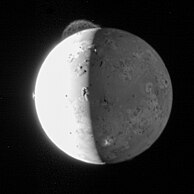
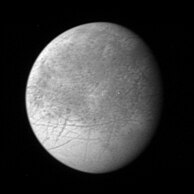
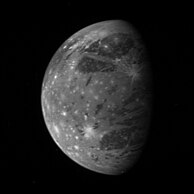
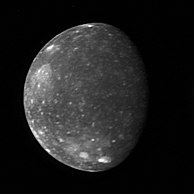

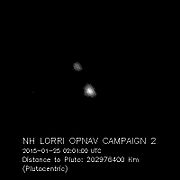
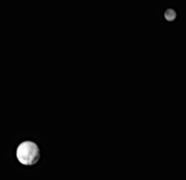





![Arrokoth among the stars of Sagittarius, imaged by New Horizons in late 2018. Its apparent magnitude from the spacecraft decreased from 20 to 15.[33]](http://upload.wikimedia.org/wikipedia/commons/thumb/3/38/Ultima_Thule_approach_video1.gif/360px-Ultima_Thule_approach_video1.gif)
![Arrokoth viewed on December 24, 2018 by LORRI[34]](http://upload.wikimedia.org/wikipedia/commons/thumb/9/9d/Newhorizonschristmasthule.png/180px-Newhorizonschristmasthule.png)


![Arrokoth as seen by LORRI during its approach, and released on January 1, 2019.[35]](http://upload.wikimedia.org/wikipedia/commons/thumb/a/a3/Detecting_Ultima_Thule%27s_Size_and_Shape_on_Approach_%28cropped%29.png/180px-Detecting_Ultima_Thule%27s_Size_and_Shape_on_Approach_%28cropped%29.png)

